Syllophopsis sechellensis
| Syllophopsis sechellensis | |
|---|---|
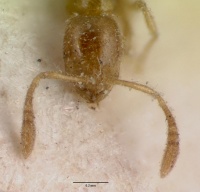
| |
| Scientific classification | |
| Kingdom: | Animalia |
| Phylum: | Arthropoda |
| Class: | Insecta |
| Order: | Hymenoptera |
| Family: | Formicidae |
| Subfamily: | Myrmicinae |
| Tribe: | Solenopsidini |
| Genus: | Syllophopsis |
| Species: | S. sechellensis |
| Binomial name | |
| Syllophopsis sechellensis (Emery, 1894) | |
| Synonyms | |
| |
| Common Name | |
|---|---|
| Kado-hime-ari | |
| Language: | Japanese |
In Japan this species is found in open habitats and nests under stones, in the bark of trees, or in plant cavities (Japanese Ant Image Database). In Madagascar, Heterick (2006) found that sifted litter is the most effective collection method for individual workers of S. sechellense, though one small nest series was taken from a rotten log. The species is found in dry tropical forest and gallery forest habitats in Antsiranana, Mahajanga and Toliara Provinces.
| At a Glance | • Invasive |
Identification
Heterick (2006) - The designation of the lectotype fixes the name of this widespread taxon, whose populations vary chiefly in the degree of cephalic punctation. Its sculptured mesopleuron immediately enables the Monomorium sechellense worker to be distinguished from the worker of Syllophopsis cryptobia and Syllophopsis modesta. Queens are larger, darker and more heavily sculptured than those of S. cryptobium.
Keys including this Species
- Key to Australian Syllophopsis species
- Key to Malagasy Erromyrma, Monomorium, Syllophopsis and Trichomyrmex species
- Key to Micronesian Ants
Distribution
Outside of Madagascar, this species has a wide distribution in the Indo-Pacific region (e.g., Bolton 1987; Wetterer 2002) and probably also occurs in Australia (Heterick 2001).
Deyrup (2016, p. 423) reported S. subcoeca from Dominica, writing ‘specimens were found by digging in an open, dry, scrub area’. These specimens from Dominica (Cabrits National Park; 2 May 2006; M. Deyrup), however, were misidentified; they are actually Syllophopsis sechellensis (M. Deyrup, pers. comm.), the first record of S. sechellensis from Dominica. (Wetterer & Sharaf, 2021)
Latitudinal Distribution Pattern
Latitudinal Range: 12.633333° to 1.299°.
| North Temperate |
North Subtropical |
Tropical | South Subtropical |
South Temperate |
- Source: AntMaps
Distribution based on Regional Taxon Lists
Afrotropical Region: Comoros, Saint Helena.
Australasian Region: Australia.
Indo-Australian Region: Borneo, Fiji, Guam, Indonesia, Malaysia, Micronesia (Federated States of), New Guinea, Northern Mariana Islands, Samoa, Singapore, Tonga.
Malagasy Region: Seychelles (type locality).
Neotropical Region: Barbados, Grenada.
Oriental Region: Cambodia, Myanmar, Thailand, Vietnam.
Palaearctic Region: Japan.
Distribution based on AntMaps
Distribution based on AntWeb specimens
Check data from AntWeb
Countries Occupied
| Number of countries occupied by this species based on AntWiki Regional Taxon Lists. In general, fewer countries occupied indicates a narrower range, while more countries indicates a more widespread species. |

|
Estimated Abundance
| Relative abundance based on number of AntMaps records per species (this species within the purple bar). Fewer records (to the left) indicates a less abundant/encountered species while more records (to the right) indicates more abundant/encountered species. |

|
Biology
Castes
Worker
Images from AntWeb
 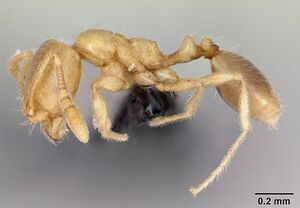  
| |
| Worker. Specimen code casent0033849. Photographer April Nobile, uploaded by California Academy of Sciences. | Owned by CAS, San Francisco, CA, USA. |
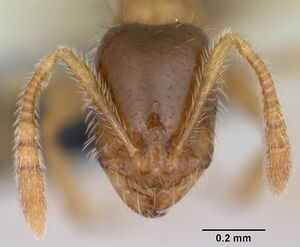   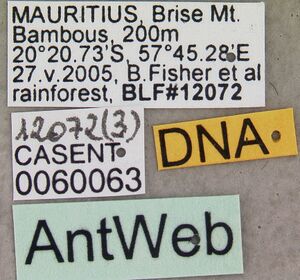
| |
| Worker. Specimen code casent0060063. Photographer April Nobile, uploaded by California Academy of Sciences. | Owned by CAS, San Francisco, CA, USA. |
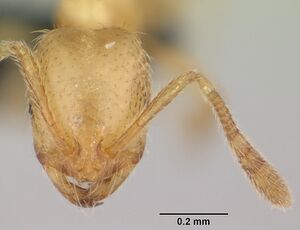   
| |
| Worker. Specimen code casent0060362. Photographer April Nobile, uploaded by California Academy of Sciences. | Owned by CAS, San Francisco, CA, USA. |
   
| |
| Worker. Specimen code casent0101271. Photographer April Nobile, uploaded by California Academy of Sciences. | Owned by MHNG, Geneva, Switzerland. |
 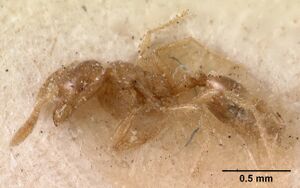 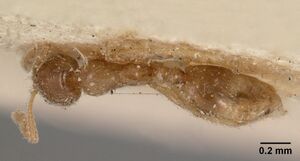 
| |
| Worker. Specimen code casent0102060. Photographer April Nobile, uploaded by California Academy of Sciences. | Owned by MSNG, Genoa, Italy. |
  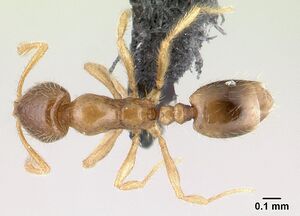 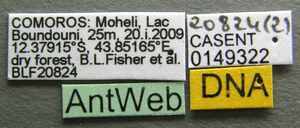
| |
| Worker. Specimen code casent0149322. Photographer Erin Prado, uploaded by California Academy of Sciences. | Owned by CAS, San Francisco, CA, USA. |
Queen
Images from AntWeb
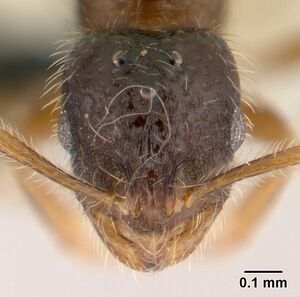 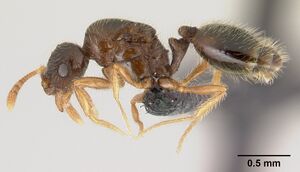 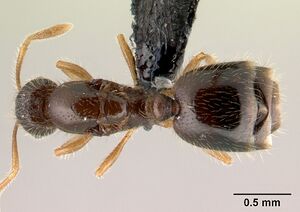 
| |
| Queen (alate/dealate). Specimen code casent0149323. Photographer Erin Prado, uploaded by California Academy of Sciences. | Owned by CAS, San Francisco, CA, USA. |
  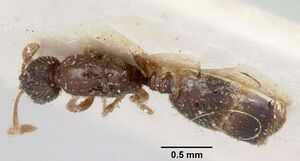 
| |
| Queen (alate/dealate). Specimen code casent0101272. Photographer April Nobile, uploaded by California Academy of Sciences. | Owned by MHNG, Geneva, Switzerland. |
 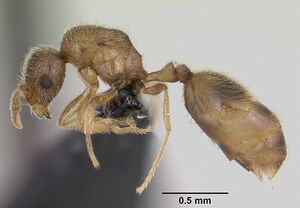  
| |
| Queen (alate/dealate). Specimen code casent0060393. Photographer April Nobile, uploaded by California Academy of Sciences. | Owned by CAS, San Francisco, CA, USA. |
Nomenclature
The following information is derived from Barry Bolton's Online Catalogue of the Ants of the World.
- sechellensis. Monomorium fossulatum subsp. sechellense Emery, 1894a: 69, fig. (w.q.) SEYCHELLES IS (Marie-Anne I.).
- Type-material: lectotype worker (by designation of Heterick, 2006: 179), 1 paralectotype worker.
- [Note: original description also mentions a syntype queen.]
- Type-locality: Seychelles: Marie-Anne I., iii.-v.1892 (Ch. Alluaud).
- Type-depository: MSNG.
- [Misspelled as seychellensis by Forel, 1907d: 93, Chapman & Capco, 1951: 165, and others.]
- Combination in Syllophopsis: Ward, et al. 2015: 73.
- Subspecies of fossulatum: Emery, 1900c: 326; Forel, 1907d: 93; Forel, 1912k: 163; Wheeler, W.M. 1922a: 1027; Emery, 1922e: 172; Wheeler, W.M. 1934h: 12; Wheeler, W.M. 1935g: 23; Chapman & Capco, 1951: 165; Ettershank, 1966: 92.
- Synonym of fossulatum: Wilson & Taylor, 1967: 64; Dorow, 1996a: 78.
- [Note: Wilson & Taylor, 1967, and Dorow, 1996a, give fossulatum as senior synonym, but sechellensis has priority (Bolton, 1995b: 266).]
- Status as species: Bolton, 1995b: 266; Wetterer, 2002: 129; Imai, et al. 2003: 133; Wetterer & Vargo, 2003: 417; Jaitrong & Nabhitabhata, 2005: 28; Heterick, 2006: 179 (redescription); Clouse, 2007b: 249; Terayama, 2009: 153; Pfeiffer, et al. 2011: 47; Sarnat & Economo, 2012: 89; Wetterer, et al. 2016: 19.
- Senior synonym of fossulatum: Bolton, 1995b: 266; Imai, et al. 2003: 133; Terayama, 2009: 153.
- Distribution: Antigua, Barbados, Fiji Is, Hawaii Is, Japan, Madagascar, Micronesia, Myanmar, Samoa, Seychelles, Taiwan, Thailand, Tonga.
- Current subspecies: nominal plus papuasiae.
- fossulatum. Monomorium fossulatum Emery, 1895k: 465 (w.q.) MYANMAR.
- Type-material: 1 syntype worker, syntype queens (number not stated, “some”).
- Type-locality: Myanmar (“Burma”): Rangoon (L. Fea).
- Type-depository: MSNG.
- Status as species: Forel, 1903a: 687; Bingham, 1903: 205; Forel, 1912a: 55; Wheeler, W.M. 1922a: 1027; Emery, 1922e: 172; Wheeler, W.M. 1929g: 60; Teranishi, 1940: 57; Chapman & Capco, 1951: 165; Ettershank, 1966: 89; Wilson & Taylor, 1967: 65; Onoyama, 1980: 198; Ogata, 1991b: 107; Morisita, et al. 1992: 39; Dlussky, 1994: 54; Dorow, 1996a: 78; Lin & Wu, 2003: 66 (error).
- Synonym of sechellensis: Wilson & Taylor, 1967: 64; Dorow, 1996a: 78.
- [Note: Wilson & Taylor, 1967, and Dorow, 1996a, give fossulatum as senior synonym, but sechellensis has priority (Bolton, 1995b: 266).]
- Junior synonym of sechellensis: Bolton, 1995b: 266; Imai, et al. 2003: 133; Terayama, 2009: 153.
Unless otherwise noted the text for the remainder of this section is reported from the publication that includes the original description.
Description
Worker
Heterick (2006) - Lectotype: HML 1.12 HL 0.41 HW 0.34 CeI 83 SL 0.31 SI 91 PW 0.23. Non-types: HML 1.07–1.24 HL 0.40–0.45 HW 0.33–0.36 CeI 78–84 SL 0.31–0.35 SI 94–100 PW 0.22–0.25 (n=20).
HEAD: Head rectangular; vertex planar or weakly concave; frons shining and smooth except for piliferous pits; pilosity of frons a mixture of incurved, semi-erect setae and slightly shorter decumbent setae. Eye minute, eyes consisting of one or two ommatidia only; (in full-face view) eyes set at about midpoint of head capsule; (viewed in profile) eyes set posteriad of midline of head capsule. Antennal segments 12; antennal club three-segmented. Clypeal carinae always weakly defined; anteromedian clypeal margin straight between strongly divergent clypeal carinae, clypeus descending almost vertically to horizontal arc of mandibles and sometimes transversely carinate below level of antennal insertions; paraclypeal setae moderately long and fine, curved; posteromedian clypeal margin extending slightly beyond level of posterior margin of antennal fossae. Anterior tentorial pits situated nearer mandibular insertions than antennal fossae. Frontal lobes sinuate, divergent posteriad. Psammophore absent. Palp formula 2,2. Mandibular teeth four; mandibles linear-triangular and smooth (except for piliferous pits); masticatory margin of mandibles strongly oblique; basal tooth approximately same size as t3 (four teeth present).
MESOSOMA: Promesonotum shining and smooth on dorsum, lower mesopleuron strongly punctate; (viewed in profile) anterior promesonotum smoothly rounded, thereafter more-or-less flattened, promesonotum on same plane as propodeum; promesonotal setae greater than twelve; standing promesonotal setae a mixture of well-spaced, distinctly longer, erect and semi-erect setae which are curved distally and often paired, interspersed with much shorter, incurved, decumbent setae; appressed promesonotal setulae few, mainly on sides of promesonotum. Metanotal groove strongly impressed, with distinct transverse costulae. Propodeum shining, dorsum and sides of propodeum mainly smooth, with weak to strong striolae on declivitous face, metapleuron also with weak to strong striolae; propodeal dorsum flat throughout most of its length; propodeum distinctly angulate, propodeal angles produced as short denticles; length ratio of propodeal dorsum to its declivity about 1:1; standing propodeal setae consisting of one prominent pair anteriad, with a few to many erect to decumbent setae on/around dorsal and declivitous faces of propodeum; appressed propodeal setulae very sparse or absent; propodeal spiracle equidistant from metanotal groove and declivitous face of propodeum. Vestibule of propodeal spiracle absent or not visible. Propodeal lobes present as vestigial flanges or small strips of cuticle only.
PETIOLE AND POSTPETIOLE: Petiolar spiracle lateral and situated slightly anteriad of petiolar node; node (viewed in profile) conical, vertex rounded; appearance of node shining and smooth throughout; ratio of greatest node breadth (viewed from front) to greatest node width (viewed in profile) about 4:3; anteroventral petiolar process absent or vestigial; ventral petiolar lobe absent; height ratio of petiole to postpetiole between 4:3 and 1:1; height–length ratio of postpetiole between 4:3 and 1:1; postpetiole shining and smooth; postpetiolar sternite without anterior lip or carina, or this structure vestigial.
GASTER: Pilosity of first gastral tergite consisting of a mixture of incurved, semi-erect setae and slightly shorter decumbent setae.
GENERAL CHARACTERS: Color pale, depigmented yellow. Worker caste monomorphic.
Queen
Heterick (2006) - HML 1.68–1.78 HL 0.48–0.51 HW 0.45–0.46 CeI 90–96 SL 0.42–0.43 SI 91–93 PW 0.41–0.43 (n=9).
HEAD: Head square; vertex weakly concave or planar; frons shining and finely longitudinally striolate and microreticulate; pilosity of frons a mixture of incurved, semierect setae and slightly shorter decumbent setae. Eye elliptical, curvature of inner eye margin may be more pronounced than that of its outer margin; (in full-face view) eyes set at about midpoint of head capsule; (viewed in profile) eyes set posteriad of midline of head capsule.
MESOSOMA: Mesoscutum broadly convex anteriad, convexity reduced posteriad; pronotum, especially, also mesoscutum and mesopleuron shining with scattered punctation, otherwise smooth; length–width ratio of mesoscutum and scutellum combined between 2:1 and 3:2; axillae separated by width of at least one axilla; standing pronotal/mesoscutal setae a mixture of well-spaced, distinctly longer, erect and semi-erect setae which are curved distally, interspersed with much shorter, incurved, decumbent setae; appressed pronotal, mescoscutal and mesopleural setulae very sparse or absent; propodeum shining, uniformly weakly striolate; propodeum distinctly angulate, propodeal angle sharp; propodeal dorsum sloping posteriad, and depressed between raised propodeal angles; standing propodeal setae consisting of up to a dozen or more longer erect and shorter sub-erect setae; appressed propodeal setulae very sparse or absent; propodeal spiracle nearer metanotal groove than declivitous face of propodeum; propodeal lobes present as well-developed, rounded flanges.
WING: Wing not seen (queens dealated).
PETIOLE AND POSTPETIOLE: Petiolar spiracle lateral and situated well anteriad of petiolar node; node (viewed in profile) cuneate, vertex tapered; appearance of node shining and microreticulate; ratio of greatest node breadth (viewed from front) to greatest node width (viewed in profile) about 4:3; anteroventral petiolar process absent or vestigial; height ratio of petiole to postpetiole about 1:1; height–length ratio of postpetiole about 4:3; postpetiole shining and microreticulate; postpetiolar sternite depressed at about its center, with anterior process developed as a short, conspicuous spur angled at 45–90.
GASTER: Pilosity of first gastral tergite consisting of a mixture of incurved, erect and semi-erect setae and slightly shorter decumbent setae.
GENERAL CHARACTERS: Color brown. Brachypterous alates not seen. Ergatoid or worker-female intercastes not seen.
Type Material
Heterick (2006) - Lectotype: worker, Seychelles, Marianne, C. Alluaud, 1892 (Museo Civico di Storia Naturale, Genoa). Paralectotype: worker, same data as above (MCSN). (Carded specimen removed from same pin as lectotype above and repinned, together with new labels.)
References
- Akbar, S.A., Bharti, H., Kanturski, M., Wachkoo, A.A. 2021. First record of the myrmicine ant genus Syllophopsis Santschi, 1915 (Hymenoptera: Formicidae) from India with description of a new species. Zootaxa 4985: 403-413 (doi:10.11646/zootaxa.4985.3.7).
- Bolton, B. 1995b. A new general catalogue of the ants of the world. Cambridge, Mass.: Harvard University Press, 504 pp. (page 266, fossulatum is given as senior name, but sechellense has priority)
- Emery, C. 1894b. Mission scientifique de M. Ch. Alluaud aux îles Séchelles (mars, avril, mai 1892). 2e mémoire. Formicides. Ann. Soc. Entomol. Fr. 63: 67-72 (page 69, fig. worker, queen described)
- Hazarika, H.N., Khanikor, B. 2021. Integration of morphological and molecular taxonomic characters for identification of Odontoponera denticulata (Hymenoptera: Formicidae:Ponerinae) with the description of the antennal sensilla. Zoologischer Anzeiger 293: 89-100 (doi:10.1016/j.jcz.2021.05.009).
- Heterick, B.E. 2006. A revision of the Malagasy ants belonging to genus Monomorium Mayr, 1855. Proceedings of the California Academy of Sciences. 57:69-202.
- Khachonpisitsak, S., Yamane, S., Sriwichai, P., Jaitrong, W. 2020. An updated checklist of the ants of Thailand (Hymenoptera, Formicidae). ZooKeys 998, 1–182 (doi:10.3897/zookeys.998.54902).
- Khudadad, S., Rafi, M.A., Zia, A., Khan, M.S., Parveen, G., Sheikh, M.K., Naz, F., Qasim, M., Shah, S.W. 2021. Ant fauna (Hymenoptera: Formicidae) of District Mansehra, Pakistan. Pakistan Journal of Agricultural Research 34: 664-671 (doi:10.17582/journal.pjar/2021/34.3.664.671).
- Wang, W.Y., Soh, E.J.Y., Yong, G.W.J., Wong, M.K.L., Benoit Guénard, Economo, E.P., Yamane, S. 2022. Remarkable diversity in a little red dot: a comprehensive checklist of known ant species in Singapore (Hymenoptera: Formicidae) with notes on ecology and taxonomy. Asian Myrmecology 15: e015006 (doi:10.20362/am.015006).
- Ward, P.S., Brady, S.G., Fisher, B.L., Schultz, T.R. 2015. The evolution of myrmicine ants: phylogeny and biogeography of a hyperdiverse ant clade (Hymenoptera: Formicidae). Systematic Entomology 40: 61–81 (doi:10.1111/syen.12090).
- Wetterer, J. 2020. First North American records of the old-world tramp ant Syllophopsis sechellensis (Hymenoptera: Formicidae). Sociobiology 67, 478-480 (doi:10.13102/sociobiology.v67i3.5014).
- Wetterer, J.K. 2021. Ants (Hymenoptera, Formicidae) of St. Vincent, West Indies. Sociobiology 68, e6725 (doi:10.13102/sociobiology.v68i2.6725).
- Wetterer, J.K. 2022. New-world spread of the Old-world Robust Crazy Ant, Nylanderia bourbonica (Forel) (Hymenoptera: Formicidae). Sociobiology, 69(2), e7343 (doi:10.13102/sociobiology.v69i2.7343).
- Wetterer, J.K., Sharaf, M.R. 2021. Worldwide distribution of Syllophopsis subcoeca (Hymenoptera: Formicidae), an Old-World species long known only from the West Indies. Journal of Natural History 55(23–24), 1465–1476 (doi:10.1080/00222933.2021.1948129).
- Wheeler, W. M. 1922k. Ants of the American Museum Congo expedition. A contribution to the myrmecology of Africa. IX. A synonymic list of the ants of the Malagasy region. Bull. Am. Mus. Nat. Hist. 4 45: 1005-1055 (see also)
- Wilson, E. O.; Taylor, R. W. 1967b. The ants of Polynesia (Hymenoptera: Formicidae). Pac. Insects Monogr. 14: 1-109 (page 64, Synonym of fossulatum (fossulatum is given as senior name, but sechellense has priority.)
References based on Global Ant Biodiversity Informatics
- Abe T.; Nakamori, M.; Uezu, K. 1976. Fauna and density of ants of a coastal limestone area in Okinawa Island. Pp. 113-120 in: Ikehara, S. (ed.) 1976. Ecological studies of nature conservation of the Ryukyu Islands - (II). Naha, Okinawa: University of the Ryukyus, 141 pp.
- Asfiya W., R. Ubaidillah, and Sk. Yamane. 2008. Ants (Hymenoptera: Formicidae) of the Krakataus, and Sebesi and Sebuku islands. Treubia 36: 1-9.
- Azuma, S. and M. Kinjo. 1987. Family Formicidae, In Checklist of the insects of Okinawa. The Biological Society of Okinawa, Nishihara. Pages 310-312.
- Chantarasawat N., D. Sitthicharoenchai, C. Chaisuekul, and C. Lekprayoon. 2013. Comparison of Ants (Hymenoptera: Formicidae) Diversity in Dry Dipterocarp and Mixed-Deciduous Forests at Sri Nan National Park, Northern Thailand. Tropical Natural History 13(1): 1-19.
- Chapman, J. W., and Capco, S. R. 1951. Check list of the ants (Hymenoptera: Formicidae) of Asia. Monogr. Inst. Sci. Technol. Manila 1: 1-327
- Eguchi K.; Bui T. V.; Yamane S. 2011. Generic synopsis of the Formicidae of Vietnam (Insecta: Hymenoptera), part I Myrmicinae and Pseudomyrmecinae. Zootaxa 2878: 1-61.
- Ettershank G. 1966. A generic revision of the world Myrmicinae related to Solenopsis and Pheidologeton (Hymenoptera: Formicidae). Aust. J. Zool. 14: 73-171.
- Forel A. 1912. H. Sauter's Formosa-Ausbeute. Formicidae (Hym.) (Schluss). Entomol. Mitt. 1: 45-61.
- Fukumoto S., Sk. Yamane, and M. Hira. 2016. Records of ants from Yoro-Shima, Amami Gunto, Japan (Hymenoptera, Formicidae). Nature of Kagoshima 42: 461–464.
- Guénard B., and R. R. Dunn. 2012. A checklist of the ants of China. Zootaxa 3558: 1-77.
- Huang Jian-hua, Zhou Shan-yi. 2007. A checklist of family Formicidae of China - Myrmicinae (Part II) (Insecta: Hymenoptera). Journal of Guangxi Normal University : Natural Science Edition 25(1): 91-99.
- Jaitrong W.; Nabhitabhata, J. 2005. A list of known ant species of Thailand. The Thailand Natural History Museum Journal 1(1): 9-54.
- Lee T. L., and Y. S. Wei. 2005. Study for the temporal and spatial variation of the ant assemblages as the biological indicator in national parks. Journal of Animal and Veterinary Advances 4(4): 491-496.
- Li Z.h. 2006. List of Chinese Insects. Volume 4. Sun Yat-sen University Press
- Nishimura M., H. Takamine, and M. Terayama. 2005. Distribution records of Aculeata (Hymenoptera) from Tsuken and Kudaka islands of Okinawa Prefecture, Japan. Tsunekibachi 5: 19-20.
- Onoyama K. 1976. A premilinary study on the ant fauna of Okinawa-ken, with taxonomic notes (Japan; Hymenoptera: Formicidae). Ecol. Stud. Nat. Cons. Ryukyu Isl. II: 121-141.
- Pfeiffer M.; Mezger, D.; Hosoishi, S.; Bakhtiar, E. Y.; Kohout, R. J. 2011. The Formicidae of Borneo (Insecta: Hymenoptera): a preliminary species list. Asian Myrmecology 4:9-58
- Terayama M. 1992. Structure of ant communities in East Asia. A. Regional differences and species richness. Bulletin of the Bio-geographical Society of Japan 47: 1-31.
- Terayama M. 1992. Structure of ant communities in east Asia. 1. Regional differences and species richness. Bull. Biogeogr. Soc. Japan 47(1): 1-31.
- Terayama M. 2009. A synopsis of the family Formicidae of Taiwan (Insecta: Hymenoptera). Research Bulletin of Kanto Gakuen University. Liberal Arts 17:81-266.
- Terayama M., S. Kubota, and K. Eguchi. 2014. Encyclopedia of Japanese ants. Asakura Shoten: Tokyo, 278 pp.
- Terayama, M. 2009. A synopsis of the family Formicidae of Taiwan (Insecta; Hymenoptera). The Research Bulletin of Kanto Gakuen University 17: 81-266.
- Torchote P., D. Sitthicharoenchai, and C. Chaisuekul. 2010. Ant species diversity and community composition in three different habitats: mixed deciduous forest, teak plantation and fruit orchard. Tropical Natural History 10(1): 37-51.
- Wetterer J.K., Sharaf, M.R. 2017. Worldwide distribution of Syllophopsis sechellensis (Hymenoptera: Formicidae). Florida Entomologist 100(2): 281-285.
- Wetterer, J.K., Sharaf, M.R. 2021. Worldwide distribution of Syllophopsis subcoeca (Hymenoptera: Formicidae), an Old-World species long known only from the West Indies. Journal of Natural History 55(23–24), 1465–1476 (doi:10.1080/00222933.2021.1948129).
- Wheeler W. M. 1929. Ants collected by Professor F. Silvestri in Formosa, the Malay Peninsula and the Philippines. Bollettino del Laboratorio di Zoologia Generale e Agraria della Reale Scuola Superiore d'Agricoltura. Portici 24: 27-64.
- Yamane S. 2016. How many species of Ants in Amami Islands? (in Japanese). Part 2, chapter 1 in How many species of Ants in Amami Islands? Pp. 92-132.
- Yamane S., S. Ikudome, and M. Terayama. 1999. Identification guide to the Aculeata of the Nansei Islands, Japan. Sapporo: Hokkaido University Press, xii + 831 pp. pp, 138-317.
- Yamane S.; Bui T. V.; Ogata K.; Okido H.; Eguchi K. 2002. Ant fauna of Cuc Phuong National Park, North Vietnam (Hymenoptera: Formicidae). Bulletin of the Institute of Tropical Agriculture Kyushu University 25: 51-62.
- Yamane S.; Ikudome, S.; Terayama, M. 1999. Identification guide to the Aculeata of the Nansei Islands, Japan. Sapporo: Hokkaido University Press, xii + 831 pp. pp138-317.

